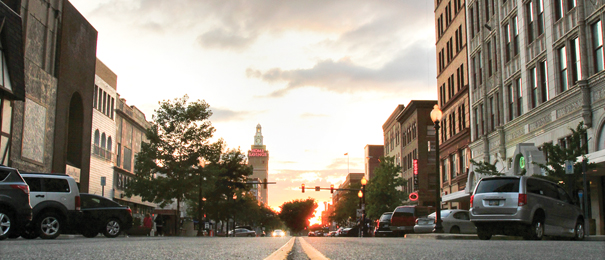Youngstown neighborhoods still evolving

RELATED: Dem defector recalls city's glory days
BY GRAIG GRAZIOSI
ggraziosi@vindy.com
YOUNGSTOWN
When I was a child I spent my weekends at my father’s family house on the South Side of Youngstown. The three-bedroom house is on a hill just above Interstate 680 overlooking the Mahoning River and downtown.
There is a large tree on the devil’s strip in front of the house that formerly had a robust network of branches and leaves that stretched higher than our roof. During the fall, I liked to go into the house’s attic — it wasn’t a finished space and had absolutely no air flow, ensuring it was always balmy and the air always stagnant — and stare out the single window facing the valley.
From that window, when the leaves had all fallen from the tree, I could see all the way to downtown. I could see the lights on the buildings and the tiny specks of light from cars zipping by on the interstate. I used to imagine, when I was older, how much I would like that space to be my room, so I could sit up there on a bed or a couch and stare out over the city.
My dad says I apparently was following in his footsteps. When he would stay home sick from the Catholic elementary school he attended in downtown Youngstown — Saints Cyril and Methodious — he would head up to the attic with his binoculars and spy on his friends while they went out for recess.
As I got older, the space became more cramped, I became less tolerant of the heat, and the ability to drive and explore replaced the escapist joy I felt staring out that window. The house has been out of our family’s possession for close to a decade now, but I still occasionally think about the view from that attic.
The house is still standing, but it’s not so for an increasing number of older, abandoned homes across the city as demolitions have become more common. To my surprise, the look of the street is still very much the same.
Thinking about Carlton Ingram – and how many more years of memories he’s got stored away about life in Youngstown – I decided to spend some time in his childhood neighborhood to get some sense of where he came from, or at very least what that area is like today.
Carlton grew up on the South Side – about 2 miles away from my father’s family home – near where Kenmore Avenue meets Glenwood Avenue, which connects downtown with the South Side and the suburb of Boardman.
Because Carlton was out of town this particular week – hanging out in Washington, D.C., with other union members – we talked over the phone. I hope to return to the area with him sometime. Maybe he’ll give me a guided tour.
For Carlton, the memories of his childhood neighborhood are now nearly half a century old, and time has taken a more noticeable toll on the streets in that section of town. Conditions vary wildly from block to block; the quality of the area clearly correlative to the number of residents still living on the street.
At the intersection of Kenmore Avenue and Overland Avenue – where Carlton used to play football with friends in a nearby field – the closest standing buildings are in various stages of disrepair. On one side of the street is a single level concrete building, covered in yellowing, chipped white paint, and whose glass-block windows have been haphazardly boarded over with thin plywood to prevent squatters.
Fifty feet up the road are a pair of abandoned two-story homes that are falling apart. The porches have collapsed into piles of wood and siding and tar, leaving the front doors – also boarded over with plywood – inaccessible without the use of a stepladder.
These images have become the dominant imagery of Youngstown in the mind of those familiar with the city for its economic depression. “Ruin porn” makes for good photos, and it’s a true symptom of the city, but it’s hardly the full picture.
Fifty feet in the opposite direction from the white concrete building is a stretch of Kenmore Avenue that has retained a handful of residents. Their houses – though nearly a century old, if not older – are still in fine condition, at least from the outside. Many of the homes sit atop their own individual little hills, with concrete stairs and maintained handrails providing walkways from the street to their front doors.
These homes are not just maintained, they’re loved; in the front yard of one house is a small stone ring encircling a rock and flower garden. Across the street another house is lined with trimmed shrubbery.
This isn’t uncommon in the older neighborhoods in the city; well-loved family homes sharing yards with the rotted husks of long abandoned domiciles.
I asked Carlton if any of his old haunts were still around, hoping to visit some little mom-and-pop grocer and chat with a Youngstown old-timer who could shed some light on what the neighborhood was like during Carlton’s heyday.
Carlton begins his response with a laugh. “No...no. Nothing’s left, not from my time.”
Even his elementary school, St. Patrick’s, is gone, now home to a large Salvation Army facility. The only other nearby business is a low-key bar with a penchant for police visits.
Youngstown may not be growing, but it is still changing; evolving in some areas and decaying in others. I wonder if either of my childhood homes will still be standing when I reach Carlton’s age.
 43
43
